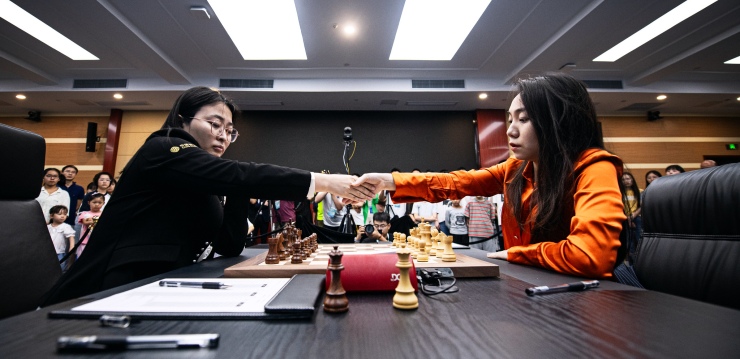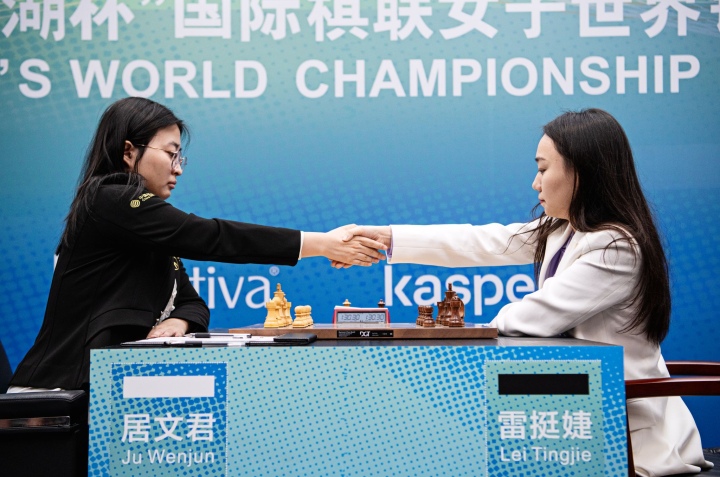
The classical part of the match for the women's world champion in chess is nearing its end, with only two more games left. The current score is 5:5
As the classical part of the match for the title of the women's world champion in chess nears its end, the appetite for risk among players is falling.
Game ten was a largely calm battle. Defending world champion Ju Wenjun opened with 1.Nf3, the same move she played in game eight when she defeated Lei. The challenger chose a slightly different response than the one in game eight, and, from an English Opening the two transitioned into a Queen's gambit position.

Despite a small imprecision by Ju in the opening, neither side managed to grab the initiative. Following exchanges in the middlegame, the two entered a drawn rook and queen endgame. Ju emerged a pawn up, but Black's active pieces offered sufficient compensation. Soon, Lei regained a pawn and, by move 32, restored material equality.
Soon Ju traded the queens and forced an even rook endgame. Despite both players being comfortable with splitting a point, neither could offer a draw before move 40. Soon, the 40th move threshold was passed, and the two happily shook hands.
The close score is evidence of the high level of play exhibited by both competitors.

Thursday, 19th July, is the final rest day of the match. Both sides will need to approach the rest day with more thought than any other rest day before: with just two more games for the final victory push, both need to be at their best. If the score remains tied after these games, the match will proceed to tiebreaks.
Game eleven will take place on Friday, 21st July, at 3 PM Local Time in Chongqing (GMT +8).
Here follows a closer look at game 10 of the match:
With the score levelled and three more games to go (including today's), it seemed that the defending World Champion had a slight advantage – she equalised the score in a critical moment to halt Lei's surge and will be playing as white in two of the last three remaining games in the classical part of the match.
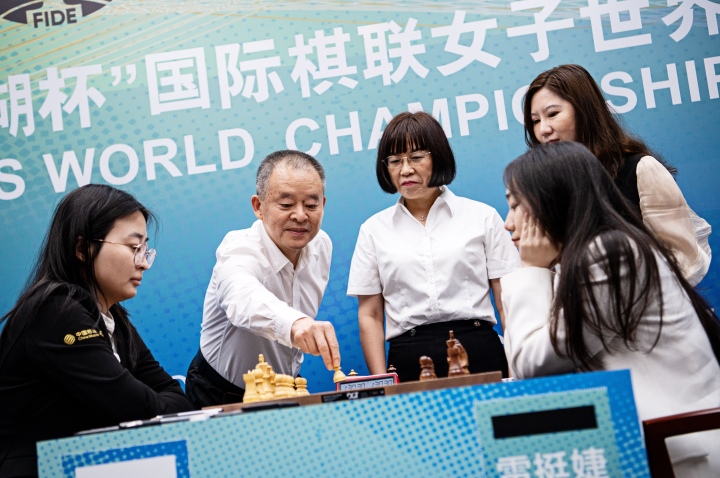
By playing 1.Nf3 the defending champion opened with the same move as in game eight, when she defeated Lei.
After some thought, Lei responded with 1…Nf6 and not 1…d5 as in game eight.
In the press conference after game nine, the players we asked if they believed in superstition. While Ju's reply was a firm "no", Lei confirmed that she did. Whether this had any play in Lei's opening move choice in today's game is anyone's guess.
Ju wanted to avoid allowing Lei to enter the Tarrasch line, where the challenger had shown great skills in the previous games. Still, from the English Opening, the two gradually transitioned into a structure of the Queen's Gambit where Black had the isolated d5-pawn – very similar to the Tarrasch Defence.

Here Ju made a slight imprecision with 14.N2f3. It allowed White to play 14…Ne4 as Black aims to seize the initiative.
Overall, during the match, Lei came across as better prepared in the openings. In all but one of the previous games, it was Lei who was better prepared in the openings and offering more surprises, noted Grandmaster Alik Gershon.
15.Nd2 "The world champion shows great character by admitting and fixing her mistake on the very next move with 15. Nd2!", said Grandmaster Alik Gershon. Still, Ju lost a tempo.
Here Lei spent 20 minutes thinking about what to do next. She had three options: To take on d4 and follow a line of exchanges or, place her knight on g5 and keep the pressure on the e4-square. The third option was 15…Qf6, with the idea of placing the queen of h6 and making mating threats on the white king as well as pinning the e3-square for some potential tactics.
After she finished calculating the lines, Lei went for the most straight-forward, 15…Nxd4, and then tried to transfer her rook to the kingside via Re6-g6 (h6). However, Ju was on her guard and thwarted this plan.
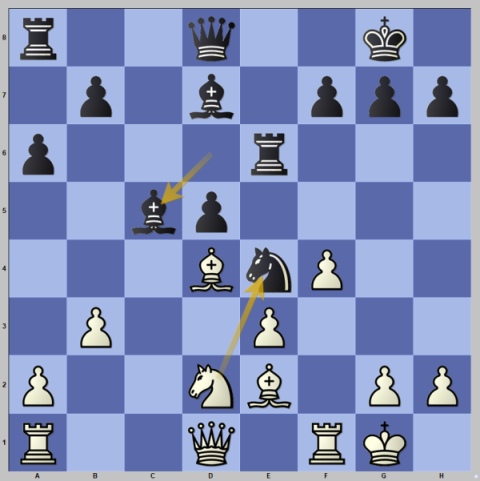
Here a series of exchanges followed, pushing the game towards a draw.
18.Nxe4 Bxd4 19.Qxd4 Rxe4 20.Qxd5 Rxe3.
An interesting moment occurred here when Ju started laughing. Despite trying to be discrete about it, it was noticeable to Lei and the audience. In the press conference, Ju explained that "something came to my mind, not about chess… Then I just couldn't stop laughing". This was not taken as a bad thing by Lei.
21.Bc4 Re7 22.Qxb7 Bb5 23.Qd5

Following the sequence of natural moves, the opponents reached a roughly equal position despite Black being a pawn down. Still, Lei was the one who needed to play more precisely here. Grandmaster Xu Yi – who knows both players well as he played with them in the Chinese leagues – noted that Lei "needs to be careful here, especially when playing against Ju", hinting at the world champion's preference to try and squeeze a victory out of a tiny advantage.
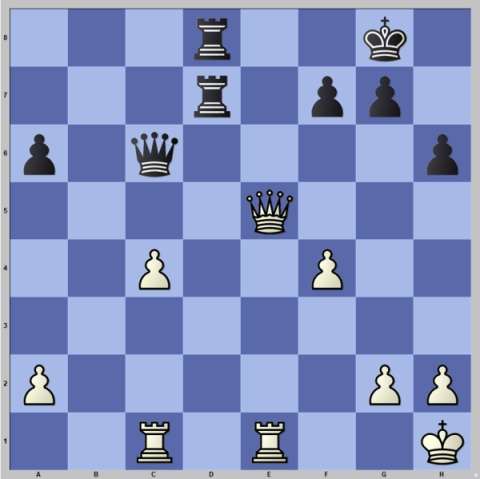
A few moves down the road, the bishops were off the board, and the two entered queen and rook endgame. Ju's extra pawn on c4 is exposed to attack, while Black's pieces are very active. Soon the c4-pawn fell, and Ju forced an exchange of queens leading to a dead-even rook endgame.

Although it was a draw, the two could not offer it to one another before move 40, as per regulations. The two played until move 47 and decided to call it a day.
On routines and rankings
The press conference after game 10 yielded some notable comments from the players about their routines and preparation.
While both were unwilling to say anything more than the ordinary about their daily habits, they did reveal one interesting detail.
When asked by the Chinese Woman Grandmaster Gu Xiaobing how many hours of sleep they get, Ju said she sleeps about eight hours a day, while Lei revealed that she sleeps as much as ten. Health experts say that a person needs, on average, about eight hours of sleep per day.
Also, Ju Wenjun was surprised to find out that she was the world's number one woman player in Rapid. When asked if she would be happy to play the rapid tiebreaks as she is the world's top woman rapid player, Ju seemed surprised and responded with a question – "Am I?"

Text: Milan Dinic
Photos: Stev Bonhage and David Llada
Official website: womenworldchampionship.fide.com/
About the Match
The match will take place in two Chinese cities, where each of the contestants comes from. The first half of the match will be in Shanghai, while the second half takes place in Chongqing.
The match will consist of 12 games of classical chess. The payers will have 90 minutes for the first 40 moves, followed by 30 more minutes for the rest of the game, plus a 30-second increment per move starting on move one.
Players cannot offer a draw before they reach the 41st move.
In case of a tie, there will be the following tiebreaks:
Four games with a 25+10 time control.
Two games with a 5+3 time control.
Two more games with a 5+3 time control.
One game with a 3+2 time control, until a winner is determined.
The prize fund is €500,000, with €300,000 going to the winner and the remaining €200,000 to the runner-up.
If the outcome of the match is decided upon tiebreaks, the winner will take €275,000, while the runner-up will receive €225,000.






